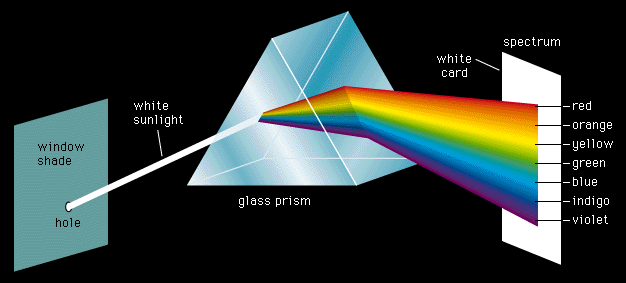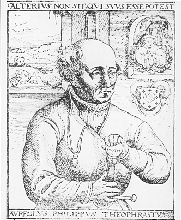

![]()
Albertus on indigo. Alchemist's Handbook.
 Indigo is Indigo
Indigo is Indigo
The postulation of seven prismatic colors, three primary and three secondary, leaves one INDIGO to be classified by itself. This classification is purely physical, as light waves can be measured and even their physical origin can be determined by spectro-analysis.
Yet all seven analyzed colors are the product of a single ray of so called white light penetrating the prism.
Now alchemists have an answer for a similar problem concerning metals by explaining that there are also seven primary metals; namely gold, silver, copper, tin, iron, lead, and mercury. Paracelsus discovered zinc, a solid metal comparable to the unstable Hg. Mercury, although a metal, is not of the same malleable nature as the first six metals.
![]()
In a like manner, Indigo, in the prismatic color scheme, is not one of the three primary or three secondary colors, but represents a seventh factor, separate from the others. Indigo, has a bluish mixed tint, just as mercury has a silvery appearance, yet neither one is what its apparent color indicates.
Indigo is not blue, nor is mercury (quicksilver) silver. If all colors can be produced from white light, then it is possible to reduce them again into white light.
What Indigo's place may be in this schematic arrangement has not yet been satisfactorily answered, but it is my hypothesis that it is the Agent to dispel (scatter) and to reorganize the different vibrations of color, similar to the role played by quicksilver among the metals.
Metals are of similar origin. All seven primary of one nature, just as the seven prismatic colors are drawn from a single beam of white light. If the origin of the prime metals has not been solved, it is due to the reluctance of science to accept the findings of the alchemists.
 Newton tried without success to win acceptance of his
theory of light.
Newton tried without success to win acceptance of his
theory of light.

Paracelsus and others also tried in vain to interest science in their findings, only to be confronted by the unseeing eye and the deaf ear of prejudice.

Philosopher's Mercury is the source of all seven primary metals, as, in like manner, white light is the source of the seven prismatic colors.


![]()
COLOR THEORY
Purloined Fulcanelli mss. about color theory concerning indigo, the prismatic entity central to the entire color - language.
To arrange the prismatic colors along the lines of principles and elements, makes one ready for the laboratory.
![]()
Key: Prismatic spectrum according to Newton.
Triangular form decomposing unitary white light by this dispersion into the seven primary prismatic colors:

Red orange yellow green blue indigo violet
![]()
Le Mystere des Cathedrales
The man who wrote the small m.s.s. that Fulcanelli stole worked on an alteration of form through salt and he noted it down in terms of the blue-indigo-violet imbroglio.
This creates an inevitable irregularity that occurs at the end of one octave and the beginning of the next.
The same irregularity occurs in the musical octave (the Diabalos in Musica) and in the planetary system. This is where the effort has to play - where the violet turns to ultraviolet and disappears for our vision. This is where the adept attempts to join the end to the beginning - have the beast bite its tail. Here is where a new red can be born, the red beyond violet, the one that is felt in violet and disappears into ultraviolet
The idea may sound strange, yet when applied to the water-salt-earth complex, it makes marvelous sense. Just as indigo and blue do not give violet, so earth and water alone do not possess the qualities to form the salt we are looking for, the fixed salt of permanence, which is an effect of spirit of perception.
It is the understanding through the organ of harmony. With this instrumentation we are capable of acting on the salt of nature.
The formal element can be and must be manipulated. Fire and water must be made to join, and this can only be effectuated through the fire of the earth. The fire of the earth must be bound to water. The important lesson here is the use of the earth-fire to accomplish the fire-water combination, the seal of Sal-Amon.
Indigo must be shifted to blue and become one of the components of violet. We are merely preparing a milieu for a new redness to become visible. Metallic forms are what we're working on, substances we know in their relation to color, not only by their lines in spectroscopy, but by other more intuitive ways. (clairvoyance?)
The result is captured in glass, and here comes the difficult manipulation of the decantations which Canselliet's letter (intro to Le Mystere des Cathedrales) talks about. The end result will be a glass that is red in the mass without being pigmented. We prepared the milieu for the phenomenon to happen, but the new octave will be attracted to the prepared milieu.
![]() Spirit
has to be caught in the net, as the Pharaonics
say. (notice the language reveals a weave pattern, cubic crystalline structure
is criss crossed).
Spirit
has to be caught in the net, as the Pharaonics
say. (notice the language reveals a weave pattern, cubic crystalline structure
is criss crossed).
The well established trinity of red, yellow, blue, is changed to a quartet, which now includes Indigo. Where this leads us: The composed colors have become principial trinity, whereas, the fundamental colors have become the four elements. By using color as a guide to an alchemical operation, it readies salt for a sulfurous fire.
![]()
MINERAL ENTITY = SALT
![]()
The idea is to effect an inscription into the mineral salt that will change its specific characteristic, speeding up its evolution, then to destroy the present form and allow the salt to become the center of attraction for a new and more evolved form. Destroy = a creative disintegration, a putrefaction without a trace of violence.
form (entity) becomes vegetative.![]()